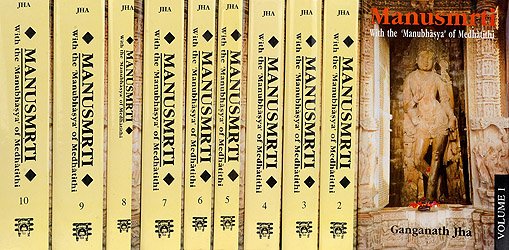Manusmriti with the Commentary of Medhatithi
by Ganganatha Jha | 1920 | 1,381,940 words | ISBN-10: 8120811550 | ISBN-13: 9788120811553
This is the English translation of the Manusmriti, which is a collection of Sanskrit verses dealing with ‘Dharma’, a collective name for human purpose, their duties and the law. Various topics will be dealt with, but this volume of the series includes 12 discourses (adhyaya). The commentary on this text by Medhatithi elaborately explains various t...
Verse 5.6
Sanskrit text, Unicode transliteration and English translation by Ganganath Jha:
लोहितान् वृक्षनिर्यासान् वृश्चनप्रभवांस्तथा ।
शेलुं गव्यं च पेयूषं प्रयत्नेन विवर्जयेत् ॥ ६ ॥lohitān vṛkṣaniryāsān vṛścanaprabhavāṃstathā |
śeluṃ gavyaṃ ca peyūṣaṃ prayatnena vivarjayet || 6 ||He shall carefully avoid the red exudation from trees, as also those flowing from incisions, the śelu berries, and ‘curdled milk’ of the cow.—(6)
Medhātithi’s commentary (manubhāṣya):
‘Exudation from trees’;—anything, apart from the constituent parts of the tree itself,—such as, the root, the trunk, the branches, the leaves, the fruits and the flowers,—which proceeds from the tree, either in the form of some liquid flowing from the cavity in the tree, or in some other form. The epithet ‘red’ excludes, from prohibition, such exudations as the camphor and the like.
Those that have their origin, source, in ‘incisions’; those that flow from the bark and such parts of the tree. These things, if not red, are not forbidden.
‘Śelu’—the śleṣmātaka fruit, to be known from medical and other treatises. It should not be taken to mean the cream of fresh milk; as it is never known to have that meaning. It has been argued that—“it is better to take the word as standing for cream, on account of its proximity to the term, ‘curdled milk’”. But proximity becomes a means of deciding in favour of one of the two possible meanings of a term, only when the term is actually found in usage to be used in both senses; but it can never be the authority for attributing an unheard of meaning to a word.
‘Of the cow’;—this shows that that of the buffalo etc. is not forbidden. The milk is unfit to be eaten if, by mere contact with fire, it becomes ‘curdled’,—i.e., thickened without adhesion; the term ‘pīyūṣa’ is used in the sense of the milk of the newly-calved cow.
“The text is going to declare, as until to be eaten, the milk, along with all its preparations, of the cow for the first ten days of its calving; and it is only during three or four days that the milk is of the nature described above (i.e., curdled by mere contact with fire) [so that no separate prohibition appears to be called for.]”
True; the thing is mentioned in the present verse with a view to those cases where the milk continues to be so ‘curdled’ even after the first ten days.
The two words—‘carefully’ and ‘avoid?—are added only for filling up the metre; since ‘unfit to be eaten’ (of verse 5) continues to be connected with all that is mentioned in the text.—(6)
Explanatory notes by Ganganath Jha
This verse is quoted in Aparārka (p. 247);—in Mitākṣarā (on 1.171), which notes that the addition of the epithet ‘red’ makes it clear that the prohibition does not apply to such exudations as assafœtida, camphor and the like;—and in Parāśaramādhava (Ācāra, p. 711), which adds—‘the red exudations’ meant are the lac and the rest,—the epithet ‘red’ indicating that such exudations as are white, e.g., assafœtida, camphor and the like—are not forbidden,—‘śelu’ is śleṣmātaka,—‘peyūṣa’ is ‘new milk,’ i.e., the milk of the newly-delivered cow, whose blood-flow has not ceased; and in support it quotes verse 8 following.
It is quoted in Vīramitrodaya (Āhnika, p. 510), which adds the following notes—‘Vṛkṣaniryāsa’ is ‘the solidified exudation from trees’,—‘Vraścana’ is cutting, and the exudations from cuttings are to be avoided even when they are not red. The prohibition does not apply to such things as assafœtida, camphor and the like,—‘śelu’ is śleṣmātaka,—and ‘peyūṣa’ is the milk of the newly dilivered cow, which solidifies at the slightest contact with fire;—in Hemādri (Śrāddha, p. 567);—and in Prāyaścittaviveka (p. 287).
Comparative notes by various authors
Gautama (17.32, 33).—(See above.)
Vaśiṣṭha (14.33).—(See above.)
Viṣṇu (51.36).—(See above.)
Yājñavalkya (1.171).—(See above.)
